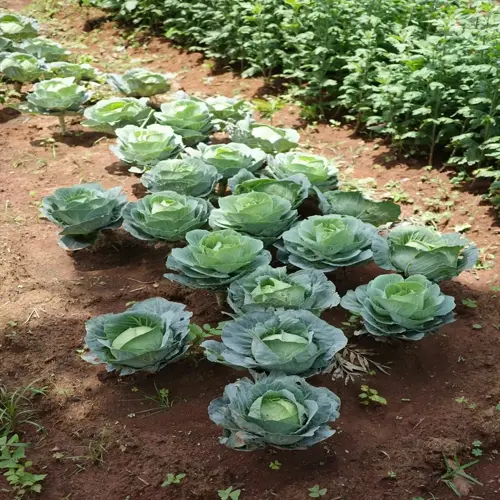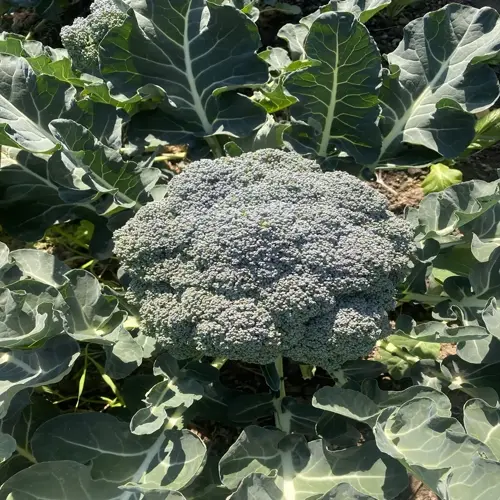When to Harvest Onions: Complete Guide

Written by
Liu Xiaohui
Reviewed by
Prof. Samuel Fitzgerald, Ph.D.To know when it's time to harvest onions, simply look for 50-90% top fall.
Harvest with the tops dry on mornings after 48+ hours of rain-free weather if possible to ensure the best chance of bulb preservation.
Curing will take 2-4 weeks while the onions are drying and we'll want to make sure the entire foliage (the greens / tops) are intact during the curing period.
Cured onions should be kept at 32-40°F (0-4°C) and with a 60-65% humidity rate.
Don't harvest when it's raining to avoid bacterial rot and fungal infection.
Don't bend the tops of the onions back to dry them faster in a premature attempt to accelerate curing, and don't store near potatoes that produce higher rates of ethylene gas.
Article Navigation
Precisely knowing when to harvest onions is critical to your crop's success. Pull too early, and the bulbs will remain small. Wait too long and they'll destroy the soil. This timing is also important for the storage shelf life and flavor intensity of your garden onions .
I figured this out the hard way in my first season. Half my crop went mushy after some heavy rain. Now, I look for definitive signs that we'll discuss later. With proper timing, I get that sweet homegrown flavor that store onions lack.
Refer to the three main indicators mentioned in more detail below - neck softening, tops falling over, and changes in bulb size. These signals will help you avoid being disappointed at harvest time. Patience will reward you with crisp bulbs that will last a long time.
Saving Onion Seeds
Onions are biennials, requiring two complete years to produce seeds. In the first year, we grow the bulb we harvest, while the second year produces flowering stalks that produce seed heads. This takes advantage of a natural two-year cycle and the requirement of having healthy bulbs to over-winter.
Observe for seed head formation after the spring bloom. Umbels form small pods that are initially green and turn tan when mature. I tend to check mine daily after the flowers wither. Several seeds, black and angular, will be ready to collect in each pod.
When most pods have turned brown, cut the seed heads with 6 inches of stem. Bundles will be upside down in paper bags. Hang in a dark, dry place for two weeks. This drying method keeps mold from forming while the seeds finish maturing.
To release seeds, rub dried pods between your hands over a bowl. Winnow out chaff outside on a breezy day. Store cleaned seeds in airtight jars with silica gel packets; they will remain viable for only one or two seasons.
Year 1: Bulb Development
- Grow onions from seed or sets through full season until maturity. Select only the largest, healthiest bulbs showing true varietal characteristics for seed production.
Year 2: Replanting and Flowering
- Replant selected bulbs in early spring after last frost. Allow plants to develop tall flower stalks that form spherical umbels of small white flowers attractive to pollinators.
Harvesting Seed Heads
- Cut seed heads when they turn completely brown and dry. Place immediately in paper bags to prevent seed loss during handling and transport to drying area.
Processing and Storage
- Crush dry seed heads to release black triangular seeds. Winnow to remove chaff before storing in airtight containers in cool, dark conditions below 40°F (4°C).
Year 1: Bulb Selection
- Choose only disease-free onions showing true varietal characteristics. Mark the best performers with colored ties for easy identification next season.
Onion Growth Timeline
Onion development consists of five distinct stages. Germination occurs when soil temperature reaches 50-75°F (10-24°C). Seeds take 7-14 days to germinate, whereas sets sprout more quickly. Moist soil is crucial, but not too wet, at this time.
To support leaf development, 55-75°F (13-24°C) air temperatures should be maintained for 4-8 weeks. Seed-grown plants typically develop more slowly than set-started plants in this situation. Usually, you will see 5-7 green leaves developing before transitioning into bulb formation, which is marked by a dark green layer of leaves at the base of the plant.
Bulb initiation occurs when the photoperiod reaches 12-14 hours of daylight. This phase lasts 2-3 weeks and requires soil temperatures around 60-70°F (16-21°C). Sets mature approximately 20 days faster than seeds during this growth stage. Proper temperatures guarantee that bulbs develop symmetrically.
In the 4-6 week bulb expansion period, maintaining consistent moisture is key. Temperature should remain below 85°F (29°C). As bulblets swell, you will count 8-13 leaves. Sets finish first but, if timed correctly, seeds produce larger storage onions.
Germination Phase
- Seeds sprout in 7-14 days at soil temperatures between 50-75°F (10-24°C). Keep soil consistently moist but not waterlogged during this critical establishment period.
Leaf Development
- Over 4-8 weeks, plants produce 5-7 green leaves. Optimal air temperatures range from 55-75°F (13-24°C) with 1 inch of water weekly for vigorous growth.
Bulb Initiation
- Triggered by day length (12-14 hours for most varieties). Lasts 2-3 weeks with soil temperatures ideally between 60-70°F (16-21°C) for proper formation.
Bulb Expansion
- 4-6 week period where bulbs rapidly swell. Requires consistent moisture and temperatures below 85°F (29°C). Plants develop 8-13 leaves during this phase.
Maturation & Drying
- Tops begin falling naturally over 1-2 weeks. Bulbs stop growing as necks tighten. Requires dry conditions with temperatures above 70°F (21°C) for curing.
Weather Considerations
Onions require specific temperature thresholds during their lifetime. Germination requires soil temperatures of 50-75°F, while bulb formation requires 60-70°F. Temperatures below 50°F and above 90°F will stop growth. I lost a crop when a sudden heat wave produced temperatures of 95°F in the expansion.
The timing of harvest depends on the risk of rain. Always wait 48 hours after the rain has dried. In my experience, wet soil causes 70% of bulbs to rot. Curing with high humidity leads to mold, which quickly kills storage potential.
Resort to frost protection when you expect temperatures to reach near freezing. Use row coverings to protect young plants. When protecting established onions, have heavy mulch prepared before a cold front arrives. I keep old blankets available for unexpected spring frosts that damage onion development.
Wind contributes two benefits during drying. Light breezes at up to 15 mph assist drying, but too strong, rough winds can damage the tops. Erect temporary windbreaks if your region receives strong wind. I use burlap screens to filter air, but not block it completely.
Temperature Extremes
- Onions stop growing below 50°F (10°C) and above 90°F (32°C). Extended heat during bulb formation often triggers premature flowering.
Rainfall During Harvest
- Harvest requires 48+ dry hours. Wet conditions significantly increase rot potential; high humidity during curing encourages fungal issues.
Frost Protection
- Use row covers when temperatures approach freezing. Mature plants tolerate light frosts, but seedlings need protection below 32°F (0°C).
Wind Exposure
- Moderate wind (5-10 mph/8-16 kph) helps curing. Strong gusts damage foliage, install barriers in exposed areas.
Sunlight Requirements
- Minimum 6 hours daily direct sun. Cloudy periods longer than 3 days during bulb expansion reduce final size by 30-40%.
Humidity Management
- Curing humidity above 60% risks mold. Ensure ventilation or use dehumidifiers in enclosed drying spaces.
Storage Methods
For perfect onion storage, they require 32-40°F (0-4°C) with 60-65% humidity. Humidity that is too high can create mold, while humidity that is too low can dry out the bulbs. I once lost a harvest by storing it at room temperature. Root cellars or unheated basements will naturally maintain these conditions.
Consider container types cautiously. Mesh bags allow airflow for small batches. Wooden crates help prevent bruising during bulk storage. Don't use plastic bins unless they are perforated. I use breathable cotton sacks for my kitchen supply and stacks of crates for cellar storage.
The transition from curing includes gradual temperature reduction. Move bulbs cooler at 5°F per day until reaching storage temperatures. Moisture will condense, ruining onions; this is avoided by the gradual transition to storage. I transition mine from a garage to basement over 7 days and check daily for moisture.
Use stringent sorting criteria before storage. Keep only bulbs with thin papery skins, firm necks, and no injuries. Discard ones with thick necks and any with soft spots whatsoever. I inspect every onion in bright light to check for unseen damage.
Mesh Bag Storage
- Ideal for basement or garage environments. Allows maximum air circulation around bulbs while preventing moisture buildup between layers.
Single-Layer Tray System
- Use wooden crates or plastic trays with ventilation holes. Prevents pressure bruising and enables easy inspection for spoiled bulbs during storage.
Pantyhose Method
- Traditional approach where onions are placed in legs of clean pantyhose with knots between bulbs. Hang in cool, dark spaces like cellars.
Braided Bunches
- Leave dried tops intact and braid 8-10 onions together. Provides decorative storage that maintains airflow around each bulb.
Perforated Plastic Bins
- Commercial solution with pre-drilled air holes. Stackable design maximizes space while maintaining necessary humidity levels below 65%.
Curing Transition Process
- Move cured onions directly to storage within 24 hours after trimming. Gradually reduce temperature by 5°F (3°C) daily until reaching 35°F (2°C) to prevent condensation.
Storage Sorting Criteria
- Select only bulbs with papery skins, tight necks, and no blemishes. Discard any with soft spots, thick necks, or signs of sprouting or mold.
Harvesting Process
Look for maturity signs before harvest. They will have 50-90% of bulbs that are naturally fallen with necks that are papery thin. Bulbs that are firm with tight, shiny skins. Gently squeeze them. I harvest when the necks crackle when you bend them, and the bulbs stop growing wider.
To ensure a clean harvest, use the proper lifting technique. Slide a garden fork approximately six inches from the bulbs at a 45-degree angle. Although you want to loosen the soil, be careful not to pierce the onions. Grasp the onions near the base of the bulb, never at the tops. Gently twist while pulling up to ensure the roots come out intact.
Be mindful of weather timing. You want to pick them during a dry morning with at least 48 hours without any rain. Ideally, temperatures should be between 60-75°F; otherwise, you will have to deal with sunscald. I had bulbs rot when harvesting after a drizzle. During the maturity period, check the forecast religiously.
Be sure to handle bulbs very gently during post-harvest steps. Place into ventilated crates immediately after harvest. Do not drop or stack more than two layers high; place with tops covering bulbs to cure in the field. Bruising should be prevented. I usually line baskets with canvas for this purpose.
Assess Maturity Signs
- Check for 50-90% fallen tops with dry, papery necks. Verify bulbs are firm and skins have developed papery outer layers before proceeding.
Choose Optimal Timing
- Harvest during dry mornings after 48+ rain-free hours. Ideal temperatures are between 60-75°F (16-24°C) to prevent sunscald on exposed bulbs.
Prepare Harvesting Tools
- Use a garden fork for compacted soil or heavy gloves for loose soil. Have baskets or crates lined with breathable fabric ready for transport.
Loosen Surrounding Soil
- Insert fork 6 inches away from bulb base at 45-degree angle. Gently rock tool to lift soil without piercing bulbs or damaging roots.
Lift and Remove Bulbs
- Grasp near bulb base, not the foliage. Twist gently while pulling upward to detach roots. Avoid shaking forcefully to prevent bruising.
Initial Field Curing
- Lay bulbs in single rows with tops covering bulbs. Leave in dry garden for 1-2 days if weather permits before moving to curing area.
Transport to Curing Site
- Carry bulbs in ventilated containers. Avoid stacking over 2 layers high to prevent compression damage during movement to drying location.
Soil-Specific Preparation
- For compacted clay: Use garden fork to aerate. For sandy soil: Hand-trowel only. Adjust tools to prevent bulb damage in different soil types.
High-Density Planting Technique
- In tightly spaced beds: Harvest every other bulb first to create working space. Use narrow hand tools to avoid disturbing neighboring plants.
Bruise Prevention Handling
- Place bulbs directly into padded containers - never drop. Use canvas-lined baskets with no more than 2 layers to prevent compression damage.
5 Common Myths
Manually bending onion tops encourages bulbs to grow larger via redirection of energy.
Forcing the tops down breaks the photosynthesis function and limits bulb expansion. Onions growing in their natural state will collapse the tops when carbohydrate transfer to the bulb is complete. Manually bending the plant will cause neck damage with rot pathogens, and will limit storage potential.
Onions that are harvested after rain will have more juiciness and better flavor quality.
Moisture that is trapped between the layers of the onion while harvesting can promote soft rot and fungal infections from bacteria. Onions that have been pulled from wet soil will spoil significantly more during curing. Onions should have had a minimum of 48 hours to dry to remove the neck moisture and prevent storage diseases.
Removing green tops soon after harvesting will stimulate the curing of onions.
Removing the tops too soon is dangerous because it causes open wounds where pathogens may gain entry and lead to neck rot. If green tops remain intact, your onions will transpire moisture at a controlled pace for the critical process of curing for a 2-4 week period. Only trim the tops once it feels papery, brittle, and dry in the neck and merely leave a 1-inch stem as a normal sealing mechanism for the bulb.
Onions will grow larger if you plant deeper than their original depth as a seedling.
Planting deeper than where the white bulb base was will smother the growth points and promote rot. The correct depth is when the shoulders of the bulb are at the level of the soil surface, allowing adequate expansion. Onions that are planted deeper will develop elongated necks, which result in moisture being trapped, limiting air circulation around the bulbs.
Storing onions near potatoes enhances longevity through mutual humidity regulation.
Potatoes release ethylene gas that triggers premature sprouting in onions. Combined humidity from both crops creates ideal conditions for mold development. Store onions separately in mesh bags at 32-40F (0-4C) with 60-65% humidity to maximize shelf life.
Conclusion
Keep in mind those harvest indicators we discussed. Fallen tops, papery necks, and firm bulbs mean the time is right. These signals will help avoid losses from harvesting too early or too late. They are better than relying on calendar dates alone.
Do not rush through the curing and storage steps. Properly drying fresh bulbs is necessary to turn them into food for the kitchen that will last throughout much of your winter. Be sure to adhere to the temperature changes and sorting methods we mentioned. Your patience at this stage will determine whether your onions last for weeks or months.
Use the guidelines for rain and timelines provided in this guide. You will now be able to correlate and expect your onions' response to the phases of growth. These best practices mitigate risk. They will thank you with better flavor and texture.
Savor the homegrown onion triumph you'll savor. Crunchy salads, flavorful soups, and caramelized masterpieces await you. That sweet flavor, which most store-bought onions lack, will become your everyday joy. Growing your own is the magic of garden-to-table.
External Sources
Frequently Asked Questions
How do I know when onions are ready to harvest?
Onions show readiness through visual cues: tops naturally fall over at 50-90% rate, necks become papery, and bulbs develop firm texture with tight skins. Harvest when these signs appear simultaneously during dry weather conditions for best results.
Is it harmful to leave onions in the ground after maturity?
Leaving mature onions in wet soil causes significant issues:
- Bulbs absorb excess moisture leading to rot
- Increased pest and disease vulnerability
- Reduced storage life due to compromised skins
- Potential re-sprouting from prolonged exposure
What are the ideal weather conditions for harvesting?
Perfect harvesting requires dry mornings after 48+ rain-free hours with temperatures between 60-75°F (16-24°C). Avoid wet conditions that trap moisture between layers and cause spoilage during curing. Sunny weather prevents sunscald while promoting field drying.
How should I handle onions immediately after harvesting?
Post-harvest handling requires careful steps to prevent damage:
- Place bulbs gently in padded containers - never drop
- Keep tops intact during initial transport
- Arrange in single layers to avoid compression bruising
- Move to curing area within 24 hours
What are common onion storage mistakes?
Critical storage errors include placing near ethylene-producing fruits like potatoes, using airtight containers without ventilation, exposing to light, and ignoring temperature/humidity controls. These cause premature sprouting, mold growth, and rapid deterioration.
Why do onions need curing before storage?
Curing transforms freshly harvested onions into storage-ready bulbs by:
- Drying outer skins to form protective barriers
- Sealing necks to prevent moisture loss
- Converting starches into storage-friendly sugars
- Killing surface pathogens through controlled drying
Should I trim onion tops before curing?
Never cut green tops immediately after harvest. Intact foliage allows gradual moisture transfer during the 2-4 week curing process. Premature trimming creates entry points for rot pathogens and compromises storage longevity significantly.
What temperature maximizes onion storage life?
Ideal storage maintains 32-40°F (0-4°C) with 60-65% humidity. This temperature range slows respiration without freezing bulbs, while controlled humidity prevents shriveling or mold. Root cellars or unheated basements work best.
How do I prevent rotting during storage?
Prevent rotting through careful preparation:
- Harvest only during dry conditions
- Discard bulbs with thick necks or blemishes
- Ensure complete curing before storage
- Regularly inspect and remove compromised onions
- Maintain consistent humidity below 65%
Can onions survive winter in the ground?
Onions cannot withstand freezing ground temperatures. Bulbs left in soil below 28°F (-2°C) suffer cellular damage and rot. Always harvest before first frost and store properly for winter use.

